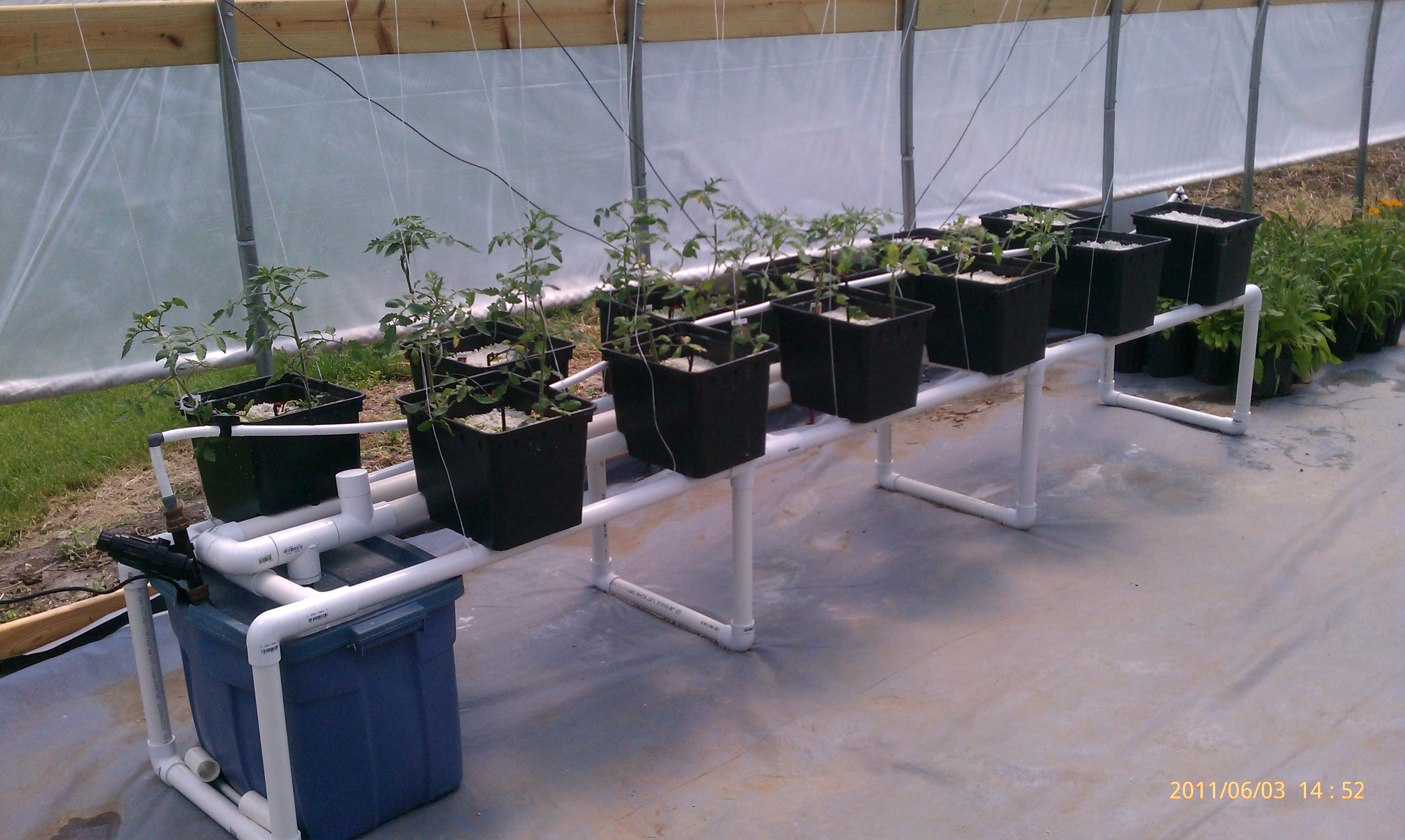Hydroponic Bucket System
You are on Page 10 of our ten page series on hydroponic bucket systems. Click on any of the below pages to jump to that page.
Page 1 Page 2 Page 3 Page 4 Page 5 Page 6 Page 7 Page 8 Page 9 Page 10

A hybrid bucket system, using purchased buckets on a homemade stand, with homemade irrigation and drain lines. The nutrient reservoir is a small Rubbermaid-type tub tucked under the stand. This is an excellent example of carefully considering the goals, the resources and the options for any given operation. Photo courtesy of Knutson Country Harvest; that page also provides more information about this particular setup.
Helpful Hints
I’ve tried to sprinkle a lot of helpful hints throughout the various sections on bato buckets. Nevertheless, there are always more helpful hints to be had. Here are a few more:
1. While many people are very attracted to DIY systems, and bato buckets are certainly a contender in that group, we’d suggest getting at least one or two actual commercial-grade bato buckets before building a DIY system. The value of doing so is that a grower will be able to handle the bucket, feel how thick the walls are, how stiff the material is, how deep the reservoir is, and where the drain line hole is located. While all this information is available as product specs, nothing quite beats actually handling a bucket. Something about turning it over in our hands gives us information which we can then use to build a better DIY system.
2. We have designed this website to focus on different production systems one at a time, just so that we can discuss everything in one place. However, growers are certainly not limited to using just one system. As we’ve discussed here, bato buckets are very well suited to large vining crops, while other hydroponic systems are better suited for other crops. We fully encourage growers to experiment with any/all these systems, depending on the crops they wish to grow and/or the system(s) which appeal to them. No rules about needing to choose one over the other. Use whatever works.
3. We have mentioned a few times that bato buckets are easy to clean and store. While best practices say to clean things before storing them, there is something about the end of the season which tells us to just pile up all the old buckets and “clean ‘em later”. Maybe it’s the falling temperatures, the desire to shut down production before really harsh weather arrives, and/or the sheer number of tasks to be done at the end of the year. Whatever the case, resist the temptation to just stack up the old pots. Wash and sterilize them first. That way, they’ll be fresh and ready to go next season which is almost certainly going to be just as busy.
4. In a similar vein, make any needed repairs or maintenance before putting equipment away for the season. That way, the grower will always start the growing season with clean, functional equipment rather than dirty equipment and forgotten repairs.
5. Bato buckets rely very heavily on drip irrigation lines, moreso than most other hydroponic systems. We’ve mentioned this before but it bears repeating: these drip irrigation lines work extremely well when nutrient is running freely through them. However, it doesn’t take much to clog them or create a leak somewhere in the lines. Check them frequently, and always keep repair/replacement materials on hand. A mature plant can survive a 20 minute repair, which is often all that’s needed. However, that same plant may not survive the drive into town and going to four different stores looking for that one little piece needed to unplug the system and restore the irrigation cycle. Carry spares and lots of them. They’ll never go stale.
More Information
The bato bucket or Dutch bucket system is very popular, and a lot of universities have extensive information on how to use them effectively. Here are just a few of these publications:
1. The University of Florida has a 60 page Dutch Bucket Production System PDF which details this approach, along with detailed information on many of the components. It also provides details on some of the most suitable crops which use bato bucket production, and which varieties are most appropriate within each crop. The PDF is intended for newcomers to hydroponics, who are interested in large-scale hobby and commercial production. That PDF can be downloaded for free from http://www.uaf.edu/files/ces/sare/conference/presentations/2015/Preconference_Workshop___Hydroponics/4-Dutch-Bucket-System-COOK.pdf
2. Hydrotek is a commercial agriculture retailer, offering a wide variety of both conventional and hydroponic production supplies, equipment and components. They offer a variety of commercial-scale Dutch bucket systems for hydroponics growers. Even if growers don’t want to purchase through Hydrotek, they offer a very detailed materials list and installation instructions which shows how a commercial-scale bato bucket system is built. The installation instructions are detailed enough to offer measurements, drain line diameters, injection system plumbing, etc. This is an excellent overview of just what sort of setup a grower would be getting into with a commercial-scale system. The download is free with no obligation to purchase from Hydrotek. That PDF can be downloaded here: https://www.growerssupply.com/wcsstore/EngineeringServices/allbizunits/techdocs/113596_97_98_99_600_601.pdf
3. As we mentioned at the beginning of the bucket system section, some growers choose to create miniature deep water culture systems in each bucket. The Volusia County (Florida) Cooperative Extension Service and the University of Florida published an interesting 42 page PDF on this very method. This PDF covers that method in detail. Furthermore, they offer instructions for how to build a DIY version of the system. The PDF can be downloaded for free here: https://www.volusia.org/core/fileparse.php/4461/urlt/Making-Your-Own-Hydroponic-Bucket.pdf
BACK
Click any of the following links to jump to that page:
Page 1 Page 2 Page 3 Page 4 Page 5 Page 6 Page 7 Page 8 Page 9 Page 10